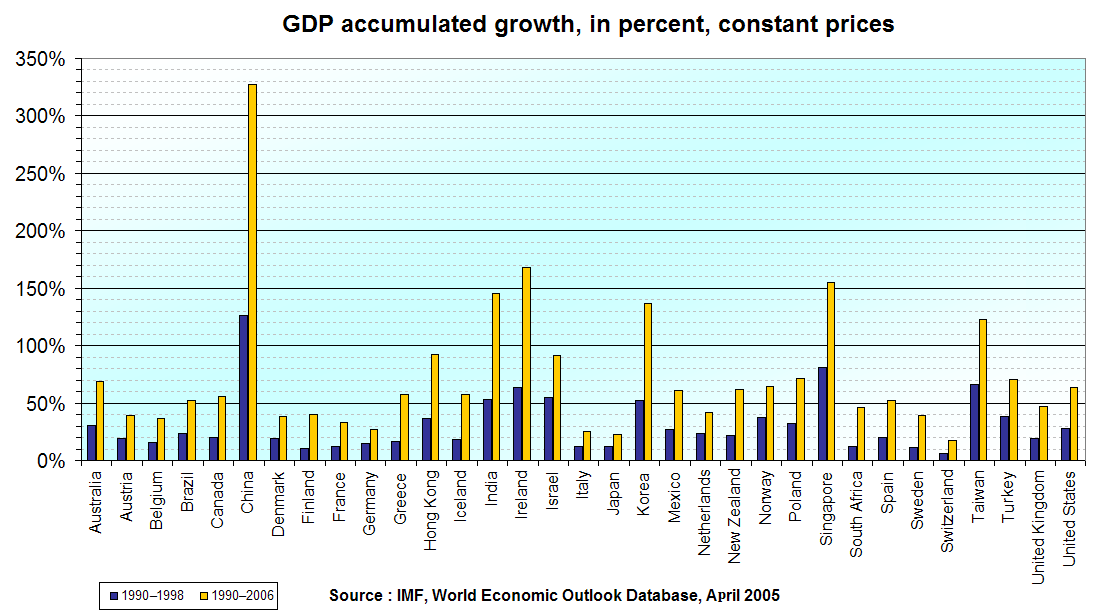
Economic growth
Economic growth can be defined as the increase or improvement in the inflation-adjusted market value of the goods and services produced by an economy in a financial year.[1] Statisticians conventionally measure such growth as the percent rate of increase in the real and nominal gross domestic product (GDP).[2]
Growth is usually calculated in real terms – i.e., inflation-adjusted terms – to eliminate the distorting effect of inflation on the prices of goods produced. Measurement of economic growth uses national income accounting.[3] Since economic growth is measured as the annual percent change of gross domestic product (GDP), it has all the advantages and drawbacks of that measure. The economic growth-rates of countries are commonly compared using the ratio of the GDP to population (per-capita income).[4]
The "rate of economic growth" refers to the geometric annual rate of growth in GDP between the first and the last year over a period of time. This growth rate represents the trend in the average level of GDP over the period, and ignores any fluctuations in the GDP around this trend.
Economists refer to economic growth caused by more efficient use of inputs (increased productivity of labor, of physical capital, of energy or of materials) as intensive growth. In contrast, GDP growth caused only by increases in the amount of inputs available for use (increased population, for example, or new territory) counts as extensive growth.[5]
Development of new goods and services also generates economic growth. As it so happens, in the U.S. about 60% of consumer spending in 2013 went on goods and services that did not exist in 1869.[6]
Other factors affecting growth[edit]
Human capital[edit]
Many theoretical and empirical analyses of economic growth attribute a major role to a country's level of human capital, defined as the skills of the population or the work force. Human capital has been included in both neoclassical and endogenous growth models.[51][52][53]
A country's level of human capital is difficult to measure since it is created at home, at school, and on the job. Economists have attempted to measure human capital using numerous proxies, including the population's level of literacy, its level of numeracy, its level of book production/capita, its average level of formal schooling, its average test score on international tests, and its cumulative depreciated investment in formal schooling. The most commonly-used measure of human capital is the level (average years) of school attainment in a country, building upon the data development of Robert Barro and Jong-Wha Lee.[54] This measure is widely used because Barro and Lee provide data for numerous countries in five-year intervals for a long period of time.
One problem with the schooling attainment measure is that the amount of human capital acquired in a year of schooling is not the same at all levels of schooling and is not the same in all countries. This measure also presumes that human capital is only developed in formal schooling, contrary to the extensive evidence that families, neighborhoods, peers, and health also contribute to the development of human capital. Despite these potential limitations, Theodore Breton has shown that this measure can represent human capital in log-linear growth models because across countries GDP/adult has a log-linear relationship to average years of schooling, which is consistent with the log-linear relationship between workers' personal incomes and years of schooling in the Mincer model.[55]
Growth theories [edit]
Adam Smith[edit]
Adam Smith pioneered modern economic growth and performance theory in his book The Wealth of Nations, first published in 1776. For Smith, the main factors of economic growth are division of labour and capital accumulation. However, these are conditioned by what he calls "the extent of the market". This is conditioned notably by geographic factors but also institutional ones such as the political-legal environment.[91]